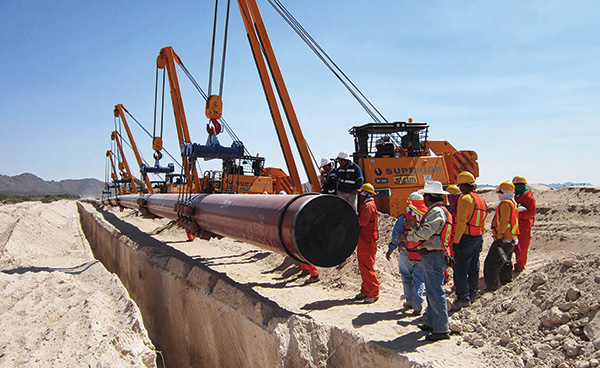October 2019, Vol. 246, No. 10
Features
Laguna-Aguascalientes Gas Pipeline Propels Growth in Mexico
By Mauro Nogarin, Contributing Editor
It is estimated that by 2026 in Mexico, natural gas demand will double the total amount of natural gas produced in 2012. Meanwhile, the current conditions suggest production will increase 2.8% annually.

The new national energy plan, through the expansion of the gas pipeline network, aims to respond to the continued economic growth of the central and southern regions of the country, by allowing development of a transport infrastructure that guarantees the supply of natural gas, based on the needs of electric energy.
Approximately 2,883 miles (4,639 km) of gas pipelines were built from 2013 through the end of 2018, and 480 miles (772 km) will be added by the end of 2019. Other projects, currently under construction, will reach 1,324 miles (2,131 km).
Another important aspect of the gas network expansion plan concerns the increasingly costly electric-power rates for small and medium industries. In recent years, this has been due, in part, to the fact that the Federal Electricity Commission (CFE) generated electricity with more expensive fuels due to a lack of natural gas in the region.
Although electric power service currently covers 98% of populated areas, the federal government wants to increase the natural gas supply capacity to companies located in the center of the country, in order to compensate for fluctuations in national supply from southeastern Mexico.
In this case, a new gas pipeline will feed the two combined cycle plants Aguascalientes 1 and 2, where the first requires 139 MMcf/d and the second 140 MMcf/d, while the third plant called Villa de Reyes Aguascalientes-Gualajara system requires 910 MMcf/d.
Between 2014 and 2015, state-owned CFE awarded contracts for the natural gas transportation service for four pipelines and two contracts in the United States. Following this plan, a contract was awarded for the design of the La Laguna-Aguascalientes gas pipeline. However, as a result of financial adjustments and social conflicts in the more than 30 communities the pipeline passes through, construction work was halted.
Meanwhile, the election of a new president of the republic in December 2018, also generated renegotiation of the contracts signed by his predecessor. Once the agreement was reached in May 2019, the contracted company, Fermaca, resumed construction work.
According to EC&P company SICIM, the construction the 48-inch, 275 miles (442 km), with a capacity of 1.2 Bcf/d, is more than 60% complete and will provide natural gas to certain CFE power plants.
The project will involve the interconnection to the El Encino-La Laguna Pipeline and the Villa de Reyes-Aguascalientes-Guadalajara pipeline through laterals and the interconnection to the compressor station located in La Laguna, Durango, as required from CFE. The construction of the 48-inch pipeline included the installation of 13 section valves supplied by CFE.
In addition, launching pig trap and receiving pig traps, and the installation of a metering system, regulating and control station (EMRyC) will have the capacity to delivery 910 MMcfd to delivery point for the Villa de Reyes Aguascalientes-Guadalajara system, including two 24-inch ultrasonic metering units.
As for the SCADA system with the conversion to RJ 45 Ethernet for the delivery of the data flow to the CFE regional sub-offices, the installation of a fiber-optic conduit is anticipated.
The pipes will be protected with an anti-corrosive coating and cathodic protection system in accordance with the ASTM G95 standard in force in Mexico. P&GJ
Pipeline Specifications
Max capacity Transport: 1,189 MMcfd
Maximum permissible operating pressure: 99.3 bar man/1,140 Psig.
Diameter: 48 inches
Length: 275 miles (442 km)
Investment: $473 million
Source: CFE





Comments